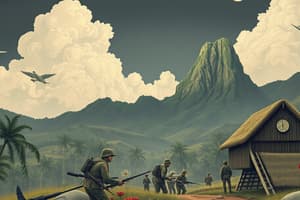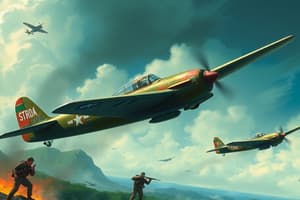Podcast
Questions and Answers
What was the North Africa Campaign focused on?
What was the North Africa Campaign focused on?
- Defeating the Soviet Union
- Gaining access to oil and raw materials (correct)
- Conquest of Italy
- Control of the Suez Canal (correct)
The Battle of Stalingrad occurred from August 1942 to February 1943.
The Battle of Stalingrad occurred from August 1942 to February 1943.
True (A)
What was the primary objective of the Italian Campaign?
What was the primary objective of the Italian Campaign?
To take Italy from Axis control.
What was The Holocaust?
What was The Holocaust?
The no-strike pledge required labor unions to wait 30 days before ___ during wartime.
The no-strike pledge required labor unions to wait 30 days before ___ during wartime.
What are wildcat strikes?
What are wildcat strikes?
What was the main task of the Office of Price Administration?
What was the main task of the Office of Price Administration?
What did the War Production Board oversee?
What did the War Production Board oversee?
The Allies used Britain's Ultra Project to gather intelligence using the ______ machine, which created codes for Germany's communication, but was also used by the British to crack them.
The Allies used Britain's Ultra Project to gather intelligence using the ______ machine, which created codes for Germany's communication, but was also used by the British to crack them.
Who was A. Philip Randolph?
Who was A. Philip Randolph?
The Fair Employment Practices Commission banned discrimination in the workplace.
The Fair Employment Practices Commission banned discrimination in the workplace.
What did the 1943 Detroit Riot signify?
What did the 1943 Detroit Riot signify?
What was the Congress of Racial Equality?
What was the Congress of Racial Equality?
What were the Navajo Code Talkers known for?
What were the Navajo Code Talkers known for?
What was the Braceros Program?
What was the Braceros Program?
What is the Zoot Suit Riot associated with?
What is the Zoot Suit Riot associated with?
What was Japanese internment?
What was Japanese internment?
The Korematsu decision declared Japanese internment as unconstitutional.
The Korematsu decision declared Japanese internment as unconstitutional.
What was the purpose of swing music during WWII?
What was the purpose of swing music during WWII?
What are USO clubs?
What are USO clubs?
What did Rosie the Riveter symbolize?
What did Rosie the Riveter symbolize?
What did Dr. New Deal and Dr. Win-the-War symbolize?
What did Dr. New Deal and Dr. Win-the-War symbolize?
What was D-Day?
What was D-Day?
What was the significance of the Battle of the Bulge?
What was the significance of the Battle of the Bulge?
What happened during the firebombing of Tokyo?
What happened during the firebombing of Tokyo?
What was The Manhattan Project?
What was The Manhattan Project?
What is radioactive fallout?
What is radioactive fallout?
The United States dropped atomic bombs over the cities of _____ at the end of WWII.
The United States dropped atomic bombs over the cities of _____ at the end of WWII.
Flashcards
North Africa Campaign
North Africa Campaign
The Allied and Axis forces fought for control of the Suez Canal and access to Middle Eastern oil and Asian raw materials. The campaign lasted from June 10, 1940, to May 13, 1943, ending with the German surrender in Tunisia.
Battle of Stalingrad
Battle of Stalingrad
Fought from August 1942 to February 2, 1943, this was a major conflict between Germany and the Soviet Union. The Germans made initial advances and captured key cities but were halted during the severe winter. It resulted in a pivotal Soviet victory and significantly weakened German forces on the Eastern Front.
Italian Campaign
Italian Campaign
A conflict involving the Allies (including the U.S., Great Britain, and the Soviet Union) to conquer Italy from 1943 to 1944. Following numerous beach landings and military operations, Italy surrendered.
The Holocaust
The Holocaust
Signup and view all the flashcards
No-Strike Pledge
No-Strike Pledge
Signup and view all the flashcards
Wildcat Strike
Wildcat Strike
Signup and view all the flashcards
Office of Price Administration (OPA)
Office of Price Administration (OPA)
Signup and view all the flashcards
War Production Board (WPB)
War Production Board (WPB)
Signup and view all the flashcards
Ultra Project; Enigma Machine
Ultra Project; Enigma Machine
Signup and view all the flashcards
A. Philip Randolph; Brotherhood of Sleeping Car Porters
A. Philip Randolph; Brotherhood of Sleeping Car Porters
Signup and view all the flashcards
Fair Employment Practices Commission
Fair Employment Practices Commission
Signup and view all the flashcards
1943 Detroit Riot
1943 Detroit Riot
Signup and view all the flashcards
Congress of Racial Equality (CORE)
Congress of Racial Equality (CORE)
Signup and view all the flashcards
Navajo Code Talkers
Navajo Code Talkers
Signup and view all the flashcards
Braceros Program
Braceros Program
Signup and view all the flashcards
Zoot Suit Riot
Zoot Suit Riot
Signup and view all the flashcards
Japanese Internment
Japanese Internment
Signup and view all the flashcards
Korematsu Decision
Korematsu Decision
Signup and view all the flashcards
Swing Music
Swing Music
Signup and view all the flashcards
USO Clubs
USO Clubs
Signup and view all the flashcards
Rosie the Riveter
Rosie the Riveter
Signup and view all the flashcards
Dr. New Deal/Dr. Win-the-War
Dr. New Deal/Dr. Win-the-War
Signup and view all the flashcards
D-Day
D-Day
Signup and view all the flashcards
The Battle of the Bulge
The Battle of the Bulge
Signup and view all the flashcards
Firebombing of Tokyo
Firebombing of Tokyo
Signup and view all the flashcards
The Manhattan Project
The Manhattan Project
Signup and view all the flashcards
Radioactive Fallout
Radioactive Fallout
Signup and view all the flashcards
Hiroshima & Nagasaki
Hiroshima & Nagasaki
Signup and view all the flashcards
Study Notes
North Africa Campaign
- Allies and Axis powers fought for control of the Suez Canal and access to Middle Eastern oil and Asian raw materials.
- Campaign lasted from June 10, 1940, to May 13, 1943, ending with German surrender in Tunisia.
Battle of Stalingrad
- Fought from August 1942 to February 2, 1943; significant conflict between Germany and the Soviet Union.
- Despite initial advances and capturing key cities, the Germans were ultimately halted during the harsh winter.
- Resulted in a pivotal Soviet victory, leading to a significant decline in German forces on the Eastern Front.
Italian Campaign
- Involved Allies, including the U.S., Great Britain, and the Soviet Union, aiming to conquer Italy from 1943 to 1944.
- Italy’s surrender followed numerous beach landings and military operations.
The Holocaust
- A tragic genocide orchestrated by the Nazis to exterminate European Jews, occurring primarily from 1942 to 1945.
- Over 6 million Jews perished during this horrific campaign.
No-Strike Pledge
- Enacted under the Smith-Connally Act in 1943, requiring labor unions to wait 30 days before striking.
- Prohibited strikes during wartime to ensure production continuity for the war effort.
Wildcat Strike
- Unauthorized strikes conducted by workers without union approval, often spontaneous and localized.
Office of Price Administration (OPA)
- Established in 1941 to combat inflation during WWII.
- Moderated price control issues but struggled against the rise of black markets and profiteering.
War Production Board (WPB)
- Created by FDR in January 1942 to oversee military purchases, though faced operational challenges.
- Complaints about contracts favoring larger companies led to eventual transition to the Office of War Mobilization.
Ultra Project; Enigma Machine
- Allies' intelligence program that successfully decoded German communications using the Enigma machine.
- Polish intelligence developed the Bombe to assist in deciphering Enigma codes.
A. Philip Randolph; Brotherhood of Sleeping Car Porters
- Leader in labor and civil rights, advocated for integrated workplaces and led the march on Washington.
- His union was the first African American organization chartered by the American Federation of Labor.
Fair Employment Practices Commission
- Established following Randolph's threats of protest, aimed at preventing workplace discrimination against African Americans.
1943 Detroit Riot
- Resulting from increased African American migration to cities for war jobs, leading to urban tension.
- The riot caused 34 deaths, primarily among the black community.
Congress of Racial Equality (CORE)
- Founded in 1942, this organization galvanized mass resistance to racial discrimination.
Navajo Code Talkers
- Native Americans who developed an unbreakable military code using their languages for secure communications.
Braceros Program
- 1942 agreement allowed Mexican contract laborers to work temporarily in the U.S. to meet labor demands in war industries.
Zoot Suit Riot
- Ethnic tensions rose in June 1943 in Los Angeles, targeting Mexican American youths wearing distinctive zoot suits, leading to violent riots.
Japanese Internment
- Over 100,000 Japanese Americans were forcibly relocated to internment camps due to wartime suspicion.
- Conditions in camps resembled prisons, despite many being loyal citizens.
Korematsu Decision
- 1944 Supreme Court ruling upheld the constitutionality of internment camps for Japanese Americans during WWII.
Swing Music
- Served as a source of comfort during the war; musicians formed military bands to boost morale.
USO Clubs
- Provided entertainment and social events for servicemen; women hostesses managed events, with strict rules on interactions.
Rosie the Riveter
- Iconic image representing the critical role of women in the industrial workforce during World War II.
Dr. New Deal/Dr. Win-the-War
- "Dr. New Deal" symbolized FDR’s focus on economic recovery, transitioning to "Dr. Win-the-War" as the emphasis shifted entirely to wartime victory.
D-Day
- Launched on June 6, 1944, as the Allied invasion of Normandy to liberate Western Europe from Nazi control.
- Involved a massive coordinated landing with extensive logistical planning and deceptive operations.
The Battle of the Bulge
- Last major German offensive on the Western Front, fought in the winter of 1944-1945.
- Named for the German advance creating a "bulge" in the Allied line, ultimately leading to significant German losses and the war's conclusion.
Firebombing of Tokyo
- A devastating air raid by the U.S. that killed 80,000; internal pressures in Japan intensified as military leaders resisted peace.
The Manhattan Project
- A secret project to develop atomic weapons led by the U.S. during WWII, aiming to outpace Germany's nuclear capabilities.
Radioactive Fallout
- Residue remaining after a nuclear explosion, indicating residual radioactivity in affected areas.
Hiroshima & Nagasaki
- Cities where the U.S. dropped atomic bombs at the end of WWII, significantly contributing to Japan's surrender.
Studying That Suits You
Use AI to generate personalized quizzes and flashcards to suit your learning preferences.




